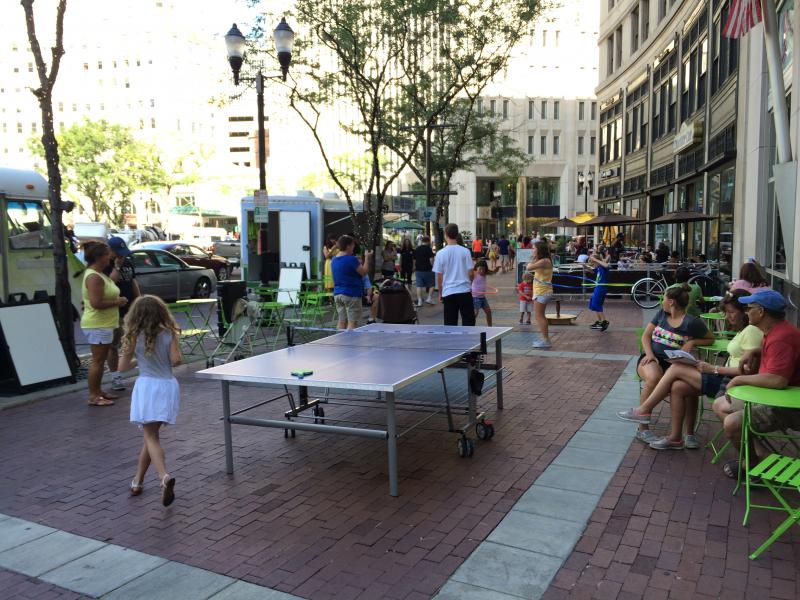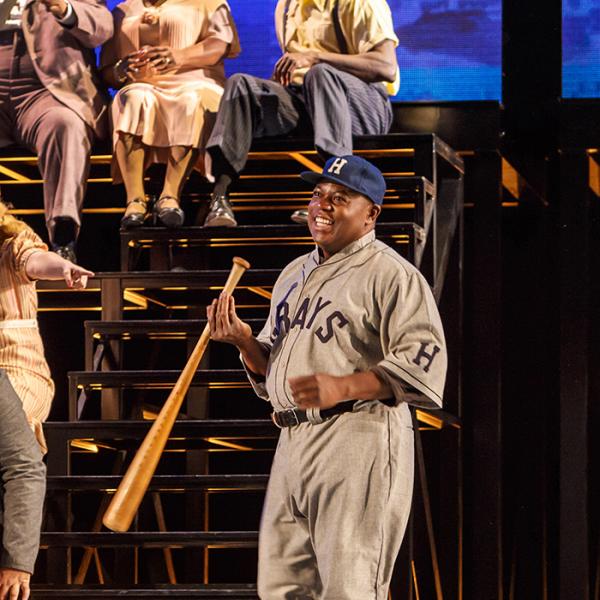Big Car: Making Every Day Art in Indiana

Big Car Collaborative's project Spark Monument Circle in Indianapolis, Indiana. Photo courtesy of Big Car
Big Car Collaborative is an arts organization rooted in Indianapolis that believes art and creativity are tools that bring communities together. It creates projects that work to improve the quality of life of neighborhoods through art and design—and its programs run from micro to macro, from the bodega on the corner to Monument Circle in the center of the city. But wherever Big Car creates, it does so with its neighbors as a full partner; it’s not art for a community, it’s art with a community.
Big Car is able to create programs that bring artists and residents together to build stronger communities because of the support it’s received on the local, state, and federal levels: from the Arts Council of Indianapolis, the Indiana Arts Commission, and the National Endowment for the Arts. As co-founders Jim Walker and Shauta Marsh explain, this combined funding is not just good for Big Car’s bottom line, it also opens doors to foundations and private donors and encourages them to expand their thinking about art.
Here are links to two short videos about Big Car Projects funded by the Indianapolis Arts Council, the Indiana Arts Commission, and the National Endowment for the Arts:
Jim Walker: Spark on Monument Circle was a $400,000 project, NEA funding matched by local funding and city funding, that put us out in the circle every day for a huge chunk of the summer and made it so that we were taking on this-- not only this big thing with the public but also this big partnership with the municipality, and learning a lot about how you work with stakeholders. You know it was a huge learning experience for us, and it was very successful.
Jo Reed: Jim is being modest: it was a massive hit for everyone: Spark brought more than 45,000 visitors to the Circle during its 11-week run. Businesses on the Circle reported a 20 percent increase in sales and people spent 85 percent more time there because of Spark. And Jim was quick to point out that even after the NEA grant had officially ended, it still had the ability to generate funds. Jim Walker: You know the match that we had for the project itself that year was just the start of the way that this leveraged funding for us, and going forward, we’ve been asked to do this kind of work in other places. We followed that up by receiving a Heart of the Community grant from Southwest Airlines with PPS, with Project for Public Spaces. So that was another way that that grant carried on, so that the program even continued the very next year because we received that grant and were able to carry on work in the same area of the city, and that would not have happened without the previous grant from the NEA and the success of that project. So there-- and there was a lot of interest in the city and there continues to be a lot of interest in the city in having this be a continued effort, and so our partnership with the city has become very strong, growing out of that initial partnership grant from Our Town. Jo Reed: Jim Walker believes that the NEA, and now the Indiana Arts Commission, are helping to reimagine how artists work in their communities. Jim Walker: There's no doubt in my mind that the NEA's leadersJhip on placemaking and seeing how the role of artists can be expanded to support their communities and their cities in these other ways-- there's no doubt that that hasn't affected our local and state funders. The Indiana Arts Commission is just now getting more into placemaking and connecting with that, and so this year we're partnering with the Arts Commission on a creative placemaking workshop and statewide conference, to get the word out and connect with people from all over the state about what placemaking is all about. And not only the Indiana Arts Commission and the Arts Council, but also the foundations, so when people see that that leadership is coming on a national level from a government funded agency, then they know that that is a smart thing and an important thing. And I like to say that when you receive an NEA grant, for that kind of work, everybody who knows anything about grants, knows that there’s the highest level of vetting, and the highest level of thoughtfulness for federal funds. And if the NEA is funding placemaking work, that's an indication that that's an important thing and a wise investment of taxpayer dollars. Jo Reed: In the past few years, first Shauta and Jim and then Big Car itself moved to Garfield Park, a neighborhood that had great potential but that had seen better days. Jim Walker: We found this tube factory vacant, talked to somebody, and it was 40 thousand dollars for a 12,000 square foot building, and we said, "Okay, we'll take it," and we had some money kind of available from some work we had done, so we were able to just buy it, and then city funding through a community development block grant, and then some other funds that we raised-- we were able to open—painted it purple, and it was this bleak gray and all boarded up, so now it’s this purple and has this bright mural by an artist named Nat Russell, and that made a big difference, we were able to turn it into this neighborhood space that is an art museum and a community space.Jo Reed: They called the space—wait for it—the Tube Factory ArtSpace—which actually is kinda perfect and they turned an empty store into a sonic art studio called Listen Hear.
Jim Walker: Listen Hear is a space for sound art. And so this is a space where you really use sound as a material for art and you have performances, art pieces that utilize sound, and then you also take sound and use that art out in the community to connect local businesses and to bring people together.
Shauta Marsh: There aren’t many dedicated sound art spaces in the United States. Oreo Jones, who’s a rapper and an artist, he’s our main curator of that space. And he has a sound lab that’s monthly and opens up to the community and allows them and teaches them how to use different electric instruments, like MOOGs.
Jim Walker: Kids really love that, and a lot of times they're the most open to it, a Oreo Jones and I have been messing with this noise box, and it's a bunch of gadgets and noisemaking things that are all hooked up, and contact mics that are all hooked up through a mixer, and then some loop sounds and effects, and we just put that thing out and let kids mess with it, and they love it, and they put on the headphones and fiddle with it, and we take that around to the library, or they come into the space and mess with it.
Shauta Marsh: We work a lot with children. They have so much fun with the sound art, you know, they love hearing themselves talk on the mic. And then we teach them how to use all that different equipment. It’s probably one of the most popular things is the sound art pieces with Oreo Jones.
Jim Walker: It's just giving people permission to experiment, and you don't know what's going to happen and that's maybe the most important part of what you're doing.
Jo Reed: And once again, it was funds from local, state, and federal arts agencies that allowed Big Car to create and program Listen Hear.
Jim Walker: The Indiana Arts Commission and the Arts Council of Indianapolis both support our programming at Listen Hear.
Shauta Marsh: NEA funded a project where we were able to commission artists who go into the community, to go into Garfield Park, and create sound art pieces.
Jim Walker: We use social media for sharing that, and we also worked with local businesses to place sound pieces in various locations and created a tour. This is also archived online.
Jim Walker: The funding from the city, the state and the federal government for the arts talks about how important this is as part of life, and it shows us as artists and it also shows the people of our city and our state and our country that this is crucial and this is vital, and when we start looking at numbers and we start looking at the percentage of our budget that comes from government funding, it's not as big of an impact in some ways as it is to have that stamp of approval, because the government is very, very careful when it comes to giving that to an arts project, because there's been scrutiny of that over the years. And so it's not a small thing. It's a big thing and it's very important from the perception end of things, and it's also very important for us on the bottom line to have that support and to know that the whims of a particular person aren't really at play here. This is an institution that is making these grants that has this ongoing strategy and approach to their funding.
Shauta Marsh: When you receive a grant from the Arts Council, or the Arts Commission, or the NEA, it’s a big deal. It really legitimatizes your organization as a whole and a lot of times they’re the first on board for a project that we’re proposing, and it makes it possible, it makes it okay to foundations to support us. It gives that green light.
Jim Walker: Sometimes people think that art is about the artist, and in some cases that might be true, but I think our art and especially the art that has been supported by the NEA and the Indiana Arts Commission, that art is also about the community, and it's not just for them, it's with them, and I think people really should understand that, and when this funding is going towards these projects, it's making a big difference because this work this happening with people who aren't artists and are people who really can feel and experience their lives being enriched by this. So I think that's been the biggest transition in the way the funding has been used, and it's also been a huge transition in the way that artists think about their practice and their work, that maybe it doesn't have to happen in a vacuum; maybe it can happen integrated with the rest of the world, and be part of all the good things that are going on in the world and make a difference in that way.
Jo Reed: That was Shauta Marsh and Jim Walker—artists and co-founders of Big Car Collaborative in Indianapolis. Find out more about it at bigcar.org. And we’re linking to videos of two of the projects mentioned Spark Monument Circle and Listen Hear. Go check them out! For NEA Arts Online, I’m Josephine Reed--thanks for listening.
Music Credit: “Annibelle June”, written and performed by Abigail Washburn and Bela Fleck. Used courtesy of Abigail Washburn. “Rules of Fullness,” from ListenHear Sound. Used courtesy of Big Car.






